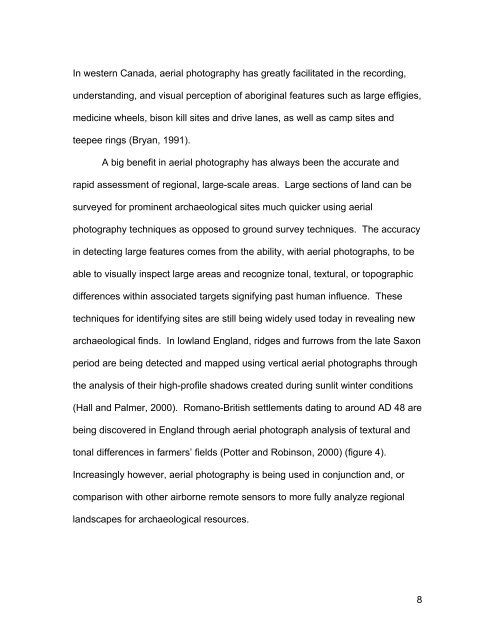A Review of Remote Sensing Application in Archaeological Research
A Review of Remote Sensing Application in Archaeological Research
A Review of Remote Sensing Application in Archaeological Research
Create successful ePaper yourself
Turn your PDF publications into a flip-book with our unique Google optimized e-Paper software.
In western Canada, aerial photography has greatly facilitated <strong>in</strong> the record<strong>in</strong>g,<br />
understand<strong>in</strong>g, and visual perception <strong>of</strong> aborig<strong>in</strong>al features such as large effigies,<br />
medic<strong>in</strong>e wheels, bison kill sites and drive lanes, as well as camp sites and<br />
teepee r<strong>in</strong>gs (Bryan, 1991).<br />
A big benefit <strong>in</strong> aerial photography has always been the accurate and<br />
rapid assessment <strong>of</strong> regional, large-scale areas. Large sections <strong>of</strong> land can be<br />
surveyed for prom<strong>in</strong>ent archaeological sites much quicker us<strong>in</strong>g aerial<br />
photography techniques as opposed to ground survey techniques. The accuracy<br />
<strong>in</strong> detect<strong>in</strong>g large features comes from the ability, with aerial photographs, to be<br />
able to visually <strong>in</strong>spect large areas and recognize tonal, textural, or topographic<br />
differences with<strong>in</strong> associated targets signify<strong>in</strong>g past human <strong>in</strong>fluence. These<br />
techniques for identify<strong>in</strong>g sites are still be<strong>in</strong>g widely used today <strong>in</strong> reveal<strong>in</strong>g new<br />
archaeological f<strong>in</strong>ds. In lowland England, ridges and furrows from the late Saxon<br />
period are be<strong>in</strong>g detected and mapped us<strong>in</strong>g vertical aerial photographs through<br />
the analysis <strong>of</strong> their high-pr<strong>of</strong>ile shadows created dur<strong>in</strong>g sunlit w<strong>in</strong>ter conditions<br />
(Hall and Palmer, 2000). Romano-British settlements dat<strong>in</strong>g to around AD 48 are<br />
be<strong>in</strong>g discovered <strong>in</strong> England through aerial photograph analysis <strong>of</strong> textural and<br />
tonal differences <strong>in</strong> farmers’ fields (Potter and Rob<strong>in</strong>son, 2000) (figure 4).<br />
Increas<strong>in</strong>gly however, aerial photography is be<strong>in</strong>g used <strong>in</strong> conjunction and, or<br />
comparison with other airborne remote sensors to more fully analyze regional<br />
landscapes for archaeological resources.<br />
8
















